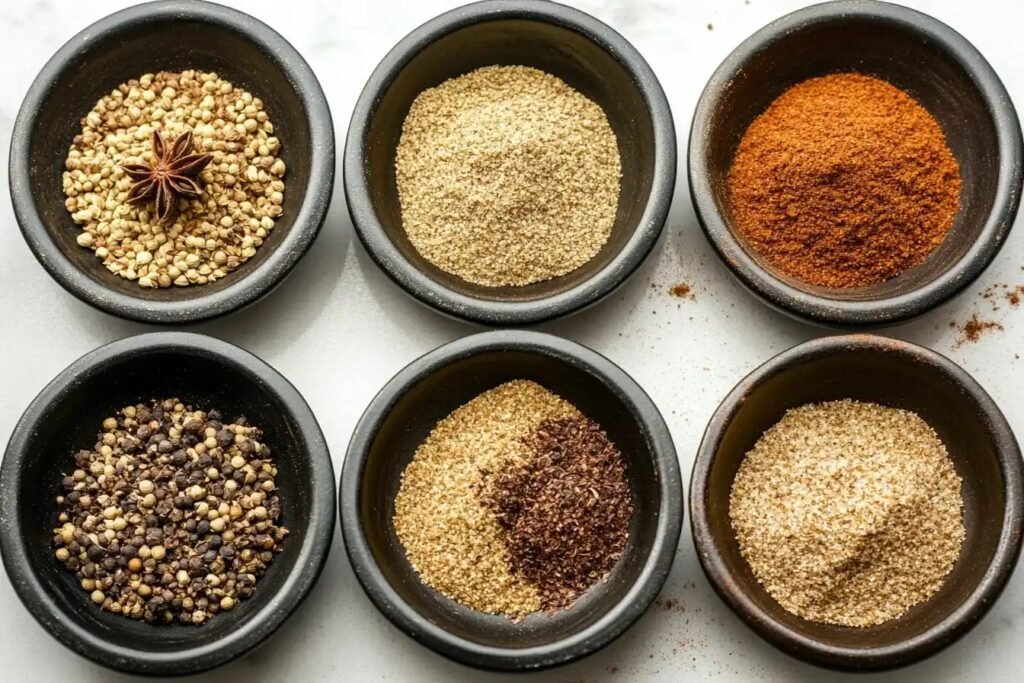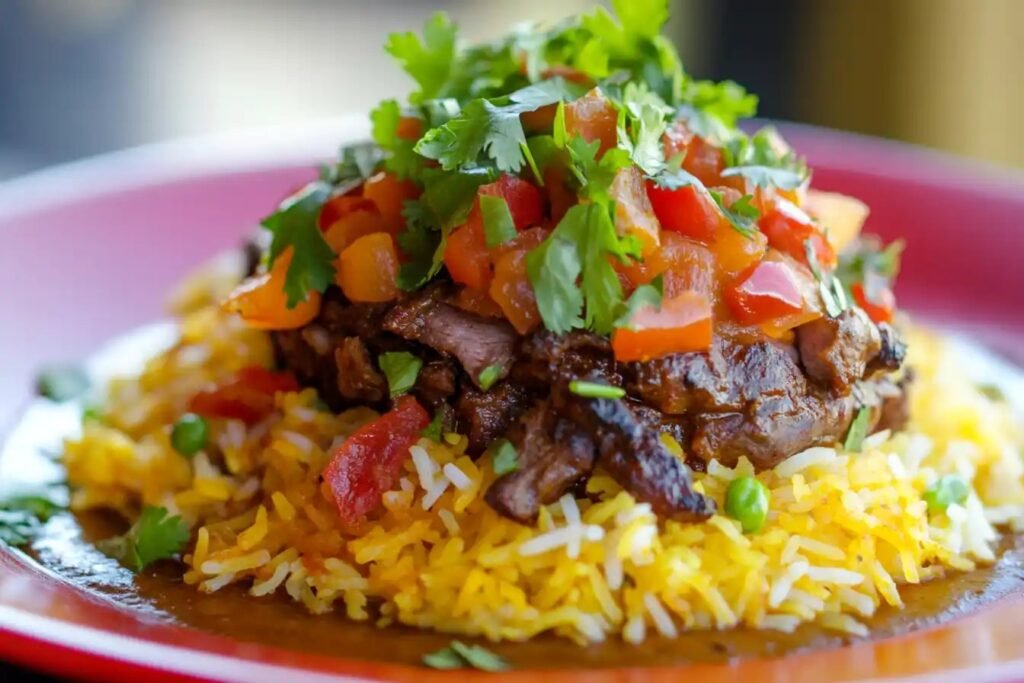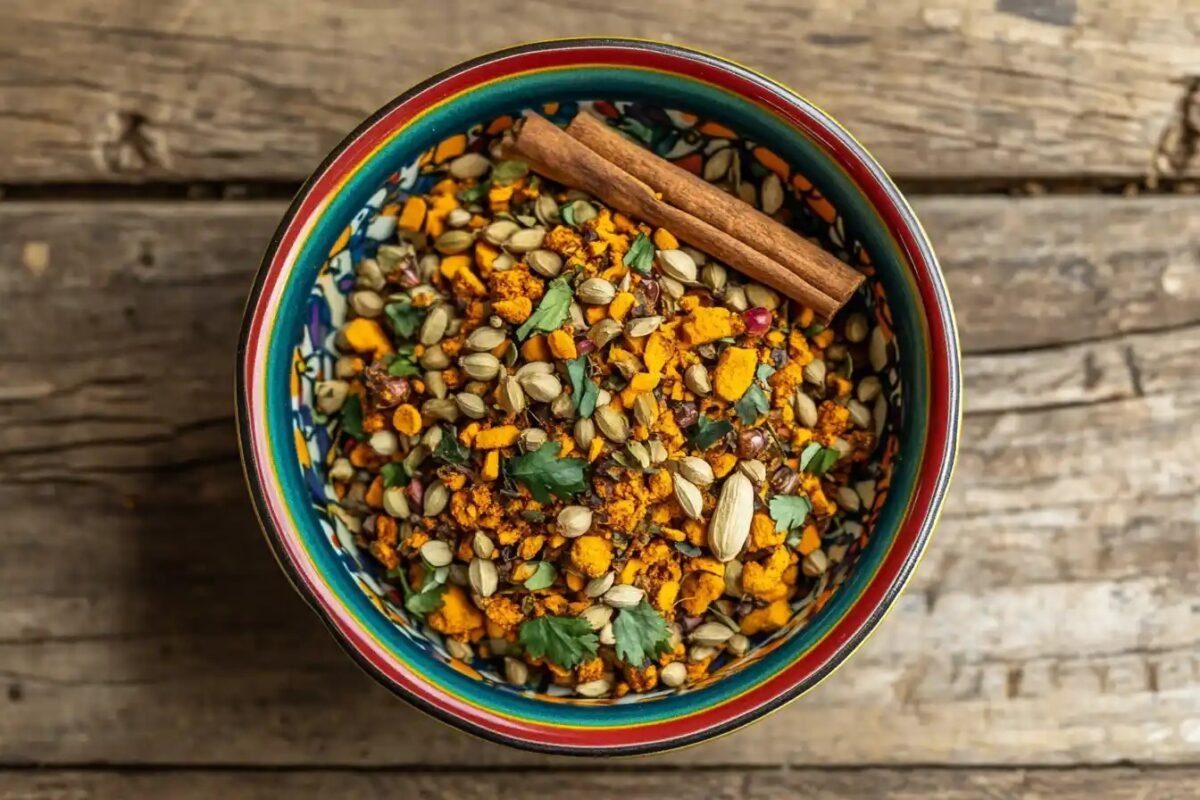Biryani is a culinary masterpiece that combines aromatic rice, succulent meats, or flavorful veggies with a symphony of spices. The secret behind its irresistible taste often lies in the Breyani mix, a spice blend packed with unique flavors and aromas. This article dives deep into what makes up this magical mix, offering insights into its components, preparation methods, and variations for different recipes. Whether you’re a seasoned chef or a curious foodie, this guide promises to unravel the mysteries of breyani mix and help you recreate its magic at home.
Introduction to Breyani Mix
What is Breyani Mix?
Breyani mix is the heart and soul of any biryani dish. It’s a meticulously curated blend of spices that delivers the rich, aromatic flavors synonymous with this iconic meal. Whether you’re preparing a meaty feast or a vegetarian delight, breyani mix elevates the dish to new heights by infusing it with layers of taste and fragrance.
This spice mix typically includes a variety of warm, earthy, and slightly sweet spices such as cumin, coriander, cinnamon, and nutmeg. However, the exact composition can vary based on cultural traditions and personal preferences.
Cultural Importance of Breyani Mix
The origins of breyani mix are deeply intertwined with the history of biryani itself, a dish that traces its roots back to South Asia. Over the centuries, different regions have adapted the recipe to reflect local flavors, resulting in diverse variations like Hyderabadi biryani, Malabar biryani, and even Middle Eastern-inspired biryani. In each case, the breyani mix serves as a flavorful bridge connecting these interpretations.
What makes breyani mix so special is its ability to unify an assortment of spices into a harmonious blend that enhances the dish’s main ingredients. It’s not just a spice mix; it’s a testament to the art of balancing flavors, where every component plays a vital role in creating a culinary masterpiece.
Key Ingredients of Breyani Mix
Primary Spices in Breyani Mix
The backbone of any breyani mix lies in its primary spices. These spices, including cumin, coriander, and turmeric, create the rich, earthy undertones biryani is famous for. Coriander seeds add a citrusy sweetness, while cumin seeds bring warmth and depth. Turmeric, with its golden hue, not only enhances the dish visually but also imparts subtle bitterness.
Other indispensable ingredients include black pepper, cloves, and cinnamon. These spices work together to add a fragrant complexity, giving the biryani its unique aromatic profile. Additionally, nutmeg and mace, often used sparingly, provide a touch of sweetness and warmth, ensuring every bite is flavorful.
Special Additives in Breyani Mix
What sets this spice blend apart from others are the distinctive additives like stone flower (kalpasi), bay leaves, and star anise. Stone flower, a rare ingredient, contributes a smoky, earthy aroma that is essential to traditional biryanis. Bay leaves, on the other hand, infuse a subtle, herby fragrance, while star anise offers a sweet licorice-like taste.
Interestingly, some versions of breyani mix may include dried rose petals or saffron, enhancing the dish’s floral and luxurious undertones. These ingredients, although not always essential, can elevate the mix’s flavor profile significantly.
Fresh vs. Store-Bought Breyani Mix
A common question is whether to opt for fresh, homemade breyani mix or a store-bought version. Homemade blends provide the freedom to customize the mix, ensuring only high-quality, fresh spices are used. On the flip side, store-bought mixes offer convenience but may contain additives like MSG or artificial flavoring. If you’re aiming for an authentic biryani experience, crafting your mix at home is always a winning choice.
For a step-by-step recipe, check out the guide on Chicken Breyani Recipe to see how these spices shine in practice.
How to Make Breyani Mix at Home
Step-by-Step Recipe for Breyani Mix

Making breyani mix at home is simpler than you think and ensures you get the freshest flavors. Start by gathering essential spices like coriander seeds, cumin seeds, fennel, and black peppercorns. Add unique elements like stone flower, bay leaves, and star anise for an authentic touch. Toast the spices lightly over medium heat until aromatic—this step unlocks their essential oils, amplifying the flavors.
Once toasted, let the spices cool before grinding them into a fine powder using a spice grinder. To achieve an even texture, you can sift the powder and grind any coarse remnants again. Store your breyani mix in an airtight container to retain its aroma and freshness for weeks.
Adjusting Spices to Taste
One of the perks of a homemade spice mix for breyani is the ability to tweak the recipe to suit your preferences. Prefer milder flavors? Reduce the quantity of black pepper and cloves. If you’re after a more intense experience, add a touch more nutmeg or mace. For vegetarian versions, you might want to emphasize lighter spices like fennel or star anise.
This DIY breyani mix isn’t just limited to biryanis. It’s a versatile spice blend that works wonderfully in curries, stews, and even rice pilaf. The flexibility it offers makes it a must-have in any kitchen.
For further insights, you can explore this article on Main Ingredients in Chicken Biryani for tips on incorporating breyani mix into your dishes.
Variations of Breyani Mix for Different Recipes
Meat-Based Biryani
For meat lovers, the breyani mix takes on a slightly richer flavor to complement proteins like chicken, lamb, or beef. In these versions, spices like black cardamom and cinnamon are used generously to add warmth and depth. The inclusion of fried onions and saffron is common, enhancing both the aroma and texture.
When preparing chicken or lamb biryani, balance is key. Too much spice can overpower the meat’s natural flavors. Instead, let the breyani mix work in harmony with the marinade and cooking techniques, creating a dish that’s both flavorful and fragrant.
If you’re interested in learning how these spices shine in specific recipes, check out this guide on Chicken Breyani Recipe.
Vegetarian Breyani Mix Options
Vegetarian biryani calls for a lighter, more floral breyani mix. While the base spices like coriander, cumin, and turmeric remain the same, you’ll want to lean on ingredients like star anise, fennel, and cardamom. These spices lend a subtle sweetness, complementing the natural flavors of vegetables or paneer.
For an even more refined taste, consider adding rose water or saffron during cooking. These elements pair beautifully with a vegetarian mix, making the dish as aromatic as it is delicious.
Fusion Styles
Fusion biryanis are gaining popularity, blending global flavors with traditional breyani mix. For instance, adding smoked paprika or oregano can bring a Mediterranean twist, while soy sauce and sesame oil create an Asian-inspired biryani. The trick is to retain the core spices like cumin and coriander to stay true to the essence of biryani.
Experimenting with fusion styles allows you to personalize the dish. Don’t be afraid to mix it up—literally and figuratively!
Common Substitutes for Breyani Mix Ingredients
Replacing Rare Spices
Sometimes, ingredients like stone flower or shahi jeera can be hard to find. Luckily, there are substitutes. Regular cumin can replace shahi jeera, though the flavor profile will be slightly less smoky. Similarly, if you can’t source stone flower, you can skip it or use a pinch of dried thyme for an earthy undertone.
Nutmeg and mace, which add subtle sweetness, can be swapped for a small dash of cinnamon. While these alternatives won’t mimic the exact taste, they’ll still keep the breyani mix flavorful.
Simplified Breyani Mix for Beginners
For beginners or those short on time, creating a simplified version of the breyani mix is an excellent idea. Focus on the essentials: coriander, cumin, turmeric, black pepper, and cardamom. These five spices capture the essence of the blend without requiring a lengthy list of ingredients.
Using a pre-made spice blend like garam masala can also work in a pinch. However, garam masala lacks the complexity of a dedicated breyani mix, so consider adding a few additional spices like star anise or bay leaves to enhance the flavor.
For more delicious recipes that incorporate spices, check out our suggestions at Quinto Recipes.
Secret Ingredients and Tips for the Perfect Breyani
Adding Depth with Aromatics
To create a truly unforgettable biryani, incorporating a few secret ingredients into the breyani mix can make all the difference. Fried onions, for instance, add a slightly sweet and savory note that beautifully complements the spices. When layered into the dish, they provide a rich caramelized flavor that elevates the entire meal.
Another essential aromatic is saffron. This luxurious spice adds a subtle floral taste and a golden hue to the rice, making the biryani visually appealing and irresistibly fragrant. Diluting a few saffron strands in warm milk or water before adding it to the rice ensures even distribution.
A dash of kewra water or rose water can also enhance the biryani’s aroma. These floral essences are particularly effective in Hyderabadi and Mughlai styles, where fragrance plays a critical role in the dish’s appeal.
Chef Tips for Elevating Your Breyani
Even the best breyani mix can fall flat without proper cooking techniques. Always toast your spices before grinding them to unlock their full potential. When using a pre-made mix, roast it briefly in hot oil or ghee during cooking to amplify its aroma.
Layering is another important technique. Alternate layers of spiced meat or vegetables with rice, ensuring the breyani mix infuses every bite. Finally, cooking the dish on low heat, or “dum,” allows the flavors to meld together, creating a harmonious blend.
By combining these secret ingredients and tips, you’ll transform an ordinary biryani into a culinary masterpiece.
FAQs About Breyani Mix
What is Breyani Mix Made Of?
Breyani mix consists of a carefully balanced blend of spices like cumin, coriander, turmeric, cinnamon, and cardamom. Additional ingredients such as stone flower, bay leaves, and star anise add complexity and depth to the flavor profile. Each spice plays a unique role, creating the bold yet harmonious taste that defines biryani.
What Are the Main Ingredients of Biryani?
The main ingredients of biryani include basmati rice, meat or vegetables, and the breyani mix. This spice blend brings the dish together by adding warmth, fragrance, and richness. Optional elements like fried onions, saffron, and yogurt further enhance the dish’s taste and texture.
What is a Substitute for Biryani Mix?
If you’re out of breyani mix, don’t worry—substitutes are readily available. A combination of garam masala, cumin, and turmeric can mimic the essential flavors. To enhance the blend, consider adding cardamom or star anise for a more authentic touch.
What is the Secret Ingredient for Biryani?
The secret ingredient for biryani often varies by region, but saffron and fried onions are universally loved for their transformative qualities. Additionally, stone flower (kalpasi) is a rare yet powerful spice that gives traditional biryanis their distinct, smoky aroma.
For more biryani inspiration, explore our Main Ingredients in Chicken Biryani guide.
Storing and Preserving Breyani Mix
Best Practices for Storing Breyani Mix
To maintain the rich aroma and flavor of your breyani mix, proper storage is key. Keep the spice blend in an airtight container, preferably made of glass, to prevent moisture and air from affecting its quality. Store it in a cool, dry place away from direct sunlight to preserve its vibrant colors and potent flavors.
For those who prepare breyani mix in large batches, consider dividing it into smaller portions. This way, you’ll only expose the amount you need, keeping the rest fresh for longer.
Shelf Life and Preservation Tips
Typically, homemade breyani mix stays fresh for up to six months when stored correctly. However, you can extend its shelf life by refrigerating or even freezing the blend. Just be sure to use a freezer-safe container and bring the mix to room temperature before using it in recipes.
Always check for signs of spoilage, like a dull aroma or clumping. If the spice blend loses its fragrance, it’s time to make a fresh batch. By following these tips, you can ensure that your breyani mix remains as flavorful as the day you made it.
For additional insights, you might enjoy exploring how spices are used in recipes like Chicken Breyani.
Why Breyani Mix Matters in Culinary Culture

A delicious biryani dish highlighting the flavors of breyani mix.
The Role of Breyani Mix in Traditional Cooking
The question “What makes up a breyani spice blend?” goes beyond its list of ingredients; it reflects the cultural significance of this aromatic mixture. Across South Asia and the Middle East, these carefully combined spices symbolize a shared love for bold, complex flavors. It’s the magic that transforms simple rice into a luxurious dish worthy of special occasions.
Whether it’s a family gathering or a festive celebration, biryani prepared with authentic breyani mix is often the centerpiece. Each spice in the blend contributes to the dish’s rich history, with variations passed down through generations.
Modern Adaptations of Breyani Mix
In today’s globalized world, breyani mix has found its way into kitchens far from its origins. Home cooks and chefs alike experiment with the blend, adapting it to suit modern tastes. While the traditional ingredients remain the foundation, creative additions like smoked paprika or dried herbs reflect contemporary culinary trends.
This adaptability ensures that the essence of breyani mix continues to evolve, delighting food lovers around the globe. By exploring its ingredients and cultural significance, you can better appreciate the vital role this spice blend plays in both traditional and modern cuisines.
To explore more recipes that celebrate spice blends, check out Quinto Recipes for inspiration.
